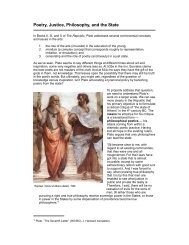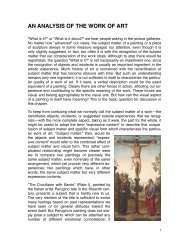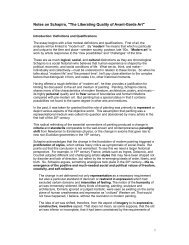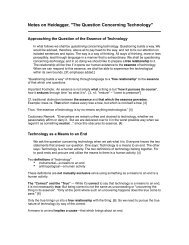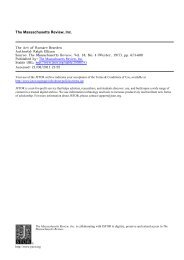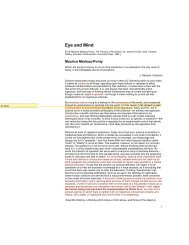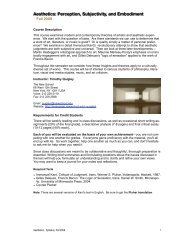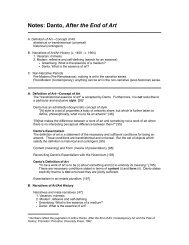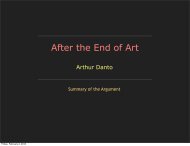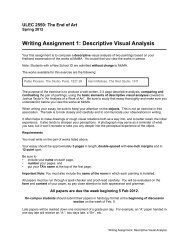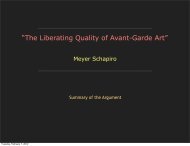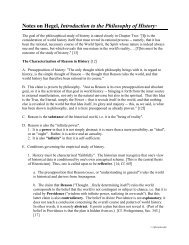Philosophical Background to the Modern World - Timothy R. Quigley
Philosophical Background to the Modern World - Timothy R. Quigley
Philosophical Background to the Modern World - Timothy R. Quigley
You also want an ePaper? Increase the reach of your titles
YUMPU automatically turns print PDFs into web optimized ePapers that Google loves.
<strong>Philosophical</strong> <strong>Background</strong> <strong>to</strong> <strong>the</strong> <strong>Modern</strong> <strong>World</strong>To set <strong>the</strong> stage for our readings and discussions this semester, it's important <strong>to</strong> review <strong>the</strong>metaphysical and on<strong>to</strong>logical beliefs that shaped intellectual life prior <strong>to</strong> <strong>the</strong> modern period sothat we can better appreciate <strong>the</strong> revolutionary changes that occurred in <strong>the</strong> intellectual andcultural climate of Europe at <strong>the</strong> end of <strong>the</strong> Middle Ages. The challenges <strong>to</strong> traditional ways ofthinking about <strong>the</strong> nature of reality and <strong>the</strong> place of human beings in <strong>the</strong> world transformedreligious, scientific, and philosophical beliefs and gave birth <strong>to</strong> concepts and practices that wetake for granted <strong>to</strong>day as "natural", "normal", belonging <strong>to</strong> common sense. It is absolutely crucial<strong>to</strong> appreciate just how radically different <strong>the</strong> pre-modern world was from both <strong>the</strong> modern and<strong>the</strong> post-modern. We'll start by looking at three competing world views: Aris<strong>to</strong>telianism,Mechanism, and Mysticism.I. Aris<strong>to</strong>telianismThere are some philosophical and existential questions that seem <strong>to</strong> appear in different forms inevery human culture. Such questions arise from <strong>the</strong> desire we feel at one time or ano<strong>the</strong>r <strong>to</strong>understand ourselves and <strong>to</strong> gain a deeper insight in<strong>to</strong> <strong>the</strong> natural world and our place within it.This often leads <strong>to</strong> a tension between <strong>the</strong> idea of <strong>the</strong> human being as a part of nature, and <strong>the</strong>human being as somehow apart from nature and <strong>the</strong> natural world of cause and effect.There was a tendency in ancient Greek philosophy going back at least <strong>to</strong> Thales (c. 585 BCE)and o<strong>the</strong>rs (e.g. <strong>the</strong> Milesians and <strong>the</strong> later A<strong>to</strong>mists) <strong>to</strong> explain nature in purely materialistterms. Various attempts were made <strong>to</strong> define matter as essentially made up of water, air, a<strong>to</strong>ms,seeds, etc. Regardless of <strong>the</strong> definition proposed, what unified <strong>the</strong> materialists was <strong>the</strong>assumption that matter was <strong>the</strong> only thing that was real.One of <strong>the</strong> problems encountered by this materialist approach was <strong>the</strong> on<strong>to</strong>logical status ofvalues. Since values are not material – that is, <strong>the</strong>y're not <strong>the</strong> sort of things one bumps in<strong>to</strong> in <strong>the</strong>dark – it follows from <strong>the</strong> fundamental assumption of materialism that <strong>the</strong>y don't exist. But giventhat human beings in every culture are concerned about <strong>the</strong> moral and ethical nature of life, andthat morality depends on value judgments, it would seem <strong>to</strong> follow that <strong>the</strong>re must be a placemade for values in any comprehensive explanation of life on earth. Thus, since <strong>the</strong> materialistscould not provide an account of values, many (including Pla<strong>to</strong>) concluded that <strong>the</strong> fundamentalassumption of materialism ("Everything is matter") must be wrong.Pla<strong>to</strong> (427-347 BCE), of course, turned <strong>the</strong> tables on <strong>the</strong> materialists by claiming that <strong>the</strong>ultimate reality was <strong>the</strong> nonmaterial world of Forms, which exist apart from <strong>the</strong> material thingswe see around us. And it was this philosophical dicho<strong>to</strong>my that Aris<strong>to</strong>tle inherited and set out <strong>to</strong>reconcile. How could <strong>the</strong>re be both material objects of sense and nonmaterial values – both real,yet fundamentally different from one ano<strong>the</strong>r?Aris<strong>to</strong>tle (384-322 BCE) approached his solution through ano<strong>the</strong>r problem that had challengedwestern thinkers for centuries, and that was <strong>the</strong> problem of identity and change. How is it thatsomething can undergo numerous changes, and yet remain <strong>the</strong> same thing throughout thosechanges? Take, for example, a chair that has been painted, re-painted, had numerous legs
eplaced, etc. At each stage, regardless of <strong>the</strong> extent and number of changes made, we think of<strong>the</strong>se as changes in <strong>the</strong> same chair even if it no longer looks like <strong>the</strong> chair we originallyacquired. A similar case can be made for our own identities, regardless of <strong>the</strong> changes that takeplace from infancy, <strong>to</strong> adulthood, and old age. No matter how much I change, it's always I whochange. How can that be?Pla<strong>to</strong>'s answer <strong>to</strong> this problem never satisfied Aris<strong>to</strong>tle. Pla<strong>to</strong> claimed that <strong>the</strong> things that are real,i.e. <strong>the</strong> Forms, are nonmaterial and, thus, are not subject <strong>to</strong> change. Ra<strong>the</strong>r <strong>the</strong>y constitute aneternal foundation for <strong>the</strong> very possibility of existence of <strong>the</strong> things in nature that are subject <strong>to</strong><strong>the</strong> constant flux, i.e. <strong>the</strong> being and becoming of natural objects. Thus, it is only <strong>the</strong> imitations ofthose Forms – <strong>the</strong> material things of this world – that change. The Forms from which <strong>the</strong>sethings are derived are eternal and, hence, remain <strong>the</strong> same. And that which makes somethinggood (<strong>the</strong> highest value) is itself a nonmaterial Form. So you see that according <strong>to</strong> Pla<strong>to</strong> changeis a kind of illusion – it's not real.Of course, this ingenious dualistic solution raised its own problems, some of which wereepistemological. For example, if <strong>the</strong>re are two worlds, as Pla<strong>to</strong> claimed – <strong>the</strong> world of Nature(appearance) and <strong>the</strong> world of Forms (reality) – and if <strong>the</strong> latter is <strong>to</strong>tally nonmaterial andinvisible, two questions arise:1. How can we possibly know anything about it?2. If it is entirely non-material, how can it interact with <strong>the</strong> material world of nature?According <strong>to</strong> Aris<strong>to</strong>tle, Pla<strong>to</strong> had gone <strong>to</strong>o far in his separation of form and matter. So Aris<strong>to</strong>tleset out <strong>to</strong> correct Pla<strong>to</strong>'s excesses by showing that appearances are not deceiving, but that <strong>the</strong>things that are real exist in matter and really do change. In <strong>the</strong> process he also managed <strong>to</strong> find aplace for values in <strong>the</strong> material, ever-changing world of nature.Form and MatterTo comprehend Aris<strong>to</strong>tle's general philosophical scheme of things and <strong>to</strong> understand his place in<strong>the</strong> intellectual world of seventeenth century European philosophy and science, we need <strong>to</strong> lookbriefly at his approach <strong>to</strong> nature and scientific explanation. Aris<strong>to</strong>tle was, in many ways, apragmatic thinker concerned with <strong>the</strong> actual conditions of life and how <strong>the</strong>y might be improved.His search for <strong>the</strong> good was a pursuit he shared with Pla<strong>to</strong>, Socrates (469-399 BCE), and o<strong>the</strong>rs.The difference is that Aris<strong>to</strong>tle was <strong>to</strong> look for his solutions in <strong>the</strong> material world of nature andnot an ideal, abstract world of immaterial forms beyond it.For Aris<strong>to</strong>tle, form is a characteristic element of <strong>the</strong> material world. He agreed with Pla<strong>to</strong> thatwe must appeal <strong>to</strong> <strong>the</strong> notion of form <strong>to</strong> explain what we see, identify, and recognize around usand <strong>to</strong> account for our knowledge of <strong>the</strong>se things. But <strong>the</strong> form that makes, for example, a treerecognizable as a tree and which allows us <strong>to</strong> know something about <strong>the</strong> nature of trees is not sofar removed as <strong>to</strong> be in some o<strong>the</strong>r world, as Pla<strong>to</strong> claimed. Ra<strong>the</strong>r, <strong>the</strong> form is embodied in thisworld and is intimately connected <strong>to</strong> matter. These forms play an important role in ourexperience of <strong>the</strong> world, even though it must be admitted that <strong>the</strong>y do have some paradoxicalfeatures.Page 2 of 12 | 17thCentBkrnd.doc
Forms are distinguishable in thought but not in fact. So, for example, we can distinguish onecolored or shaded square from ano<strong>the</strong>r,but we never experience a square with no color or shade at all, nor do we perceive a color withno shape. What happens here, according <strong>to</strong> Aris<strong>to</strong>tle's doctrine, is that we separate <strong>the</strong> form from<strong>the</strong> material thing in our minds through intellectual abstraction and analysis. But it doesn'tfollow that forms can exist apart from <strong>the</strong> material objects.So what is <strong>the</strong> proper way <strong>to</strong> think about <strong>the</strong> relation of form and matter? First of all, we mus<strong>to</strong>bserve that <strong>the</strong> world is divided in<strong>to</strong> beings and becomings. Everything in <strong>the</strong> material world ofnature is in <strong>the</strong> process of "becoming", i.e. everything is undergoing continual change in <strong>the</strong>process of birth, growth, decay, and death. This process of change can be analyzed in <strong>the</strong> mostgeneral Aris<strong>to</strong>telian terms as a movement from <strong>the</strong> "out-of-which" (that from which a thingmoves or emerges) <strong>to</strong> <strong>the</strong> "in<strong>to</strong>-which" (that <strong>to</strong>ward which <strong>the</strong> thing is moving, which it isbecoming).Now, <strong>to</strong> understand and <strong>to</strong> gain knowledge of a thing we must first be able <strong>to</strong> differentiate itfrom o<strong>the</strong>r things, in o<strong>the</strong>r words it must be articulated in our experience. 1 This articulationprovides <strong>the</strong> answer <strong>to</strong> <strong>the</strong> question which thing we're looking at or talking about. As we lookin<strong>to</strong> a room, we distinguish chairs, tables, walls, and human beings from one ano<strong>the</strong>r in virtue of<strong>the</strong> fact that <strong>the</strong>y are different particular things. But we move quickly in our experience beyond<strong>the</strong> mere "whichness" of a thing <strong>to</strong> a recognition of <strong>the</strong> kind of thing it is, a process that relies ona definition of <strong>the</strong> form in<strong>to</strong> which <strong>the</strong> particular thing (<strong>the</strong> matter) has developed. Thus, ourability <strong>to</strong> differentiate allows us <strong>to</strong> say which thing it is; <strong>the</strong> form tells us what <strong>the</strong> thing is.But in addition <strong>to</strong> <strong>the</strong> formal classification of <strong>the</strong> thing, <strong>the</strong> definition also specifies a function orpurpose, i.e. what <strong>the</strong> thing is capable of doing and what end it serves. This is whereexplanation comes in<strong>to</strong> <strong>the</strong> picture. Explanation is an attempt <strong>to</strong> account for why <strong>the</strong> thing has acertain kind of form. So, for example, according <strong>to</strong> Aris<strong>to</strong>tle <strong>the</strong> function of a chair is <strong>to</strong> allowone <strong>to</strong> sit, which explains why it has <strong>the</strong> form it does; <strong>the</strong> function of a shoe is <strong>to</strong> support andprotect <strong>the</strong> foot, which explains <strong>the</strong> general form of <strong>the</strong> shoe; etc. Thus, <strong>to</strong> answer <strong>the</strong> whyquestionone must have knowledge, and knowledge according <strong>to</strong> Aris<strong>to</strong>tle is always of <strong>the</strong> formof a thing, not <strong>the</strong> matter. That's because <strong>the</strong> matter can vary, but <strong>the</strong> form must be roughly <strong>the</strong>same from shoe <strong>to</strong> shoe, chair <strong>to</strong> chair, tree <strong>to</strong> tree, etc. And since knowledge is of things thatstay <strong>the</strong> same (which accounts for its permanence and reliability), and since it is <strong>the</strong> matter thatchanges, explanation and knowledge are relative <strong>to</strong> <strong>the</strong> form of things.Take, for example, a solid rectangular object. We might ask, "What is it?" The answer could be,"It's a brick." But how would we know this? What makes it a brick? Aris<strong>to</strong>tle's answer is, "Its1 Notice that our discussion is becoming increasingly abstract as we look in<strong>to</strong> <strong>the</strong> metaphysical and fundamental nature of reality.This is not uncommon in philosophical analysis. But it does take some getting used <strong>to</strong>. By all means don't hesitate <strong>to</strong> ask aquestion if you feel you're getting lost in <strong>the</strong> fog.Page 3 of 12 | 17thCentBkrnd.doc
form." The fact that it's made of clay is largely irrelevant. Its being clay is not what makes it abrick, but ra<strong>the</strong>r <strong>the</strong> uses <strong>to</strong> which <strong>the</strong> clay is put, viz. <strong>to</strong> build a wall. Vases can be made of clay,and so can <strong>to</strong>ys, cups, and tiles. What makes <strong>the</strong>se things <strong>the</strong> kind of things <strong>the</strong>y are is <strong>the</strong> formtaken by <strong>the</strong> clay, and <strong>the</strong> form is determined by <strong>the</strong> function and purpose of <strong>the</strong> thing.It's <strong>the</strong> form that gives a thing its unity and wholeness. The matter, on <strong>the</strong> o<strong>the</strong>r hand, containswithin it <strong>the</strong> possibility of being a certain kind of thing, whe<strong>the</strong>r brick, vase, cup, or tile. Thissuggests <strong>the</strong> "relativity of form and matter". The bricks can be formed in<strong>to</strong> a wall – <strong>the</strong>y containthat as a possibility. And when <strong>the</strong> wall is built, we say <strong>the</strong> matter is made up of <strong>the</strong> bricks, and<strong>the</strong> form is <strong>the</strong> wall whose purpose is <strong>to</strong> provide an enclosure. Now when <strong>the</strong> walls are used <strong>to</strong>build a house, <strong>the</strong>n <strong>the</strong> walls become <strong>the</strong> matter and <strong>the</strong> house becomes <strong>the</strong> form. Thus, at everystage of becoming we look back <strong>to</strong> <strong>the</strong> matter and forward <strong>to</strong> <strong>the</strong> form, structure, and function. Inthis sense, <strong>the</strong> world is a hierarchy of individuals related in such a way so that each thing is both<strong>the</strong> fulfillment of a purpose – an actuality – and <strong>the</strong> possibility of a future development – apotentiality.So far we've been talking mostly about things made by human beings – things such as chairs,shoes, bricks, and walls. But Aris<strong>to</strong>tle applied this way of thinking based on form and matter <strong>to</strong>all things including objects, which acquire <strong>the</strong>ir purposes and functions "naturally". So, forAris<strong>to</strong>tle, it makes sense <strong>to</strong> ask about <strong>the</strong> function of <strong>the</strong> heart, which is <strong>to</strong> pump blood. This is afunction it has by nature, not through human intervention and design (unless, of course, it's anartificial heart). This marks ano<strong>the</strong>r major distinction in Aris<strong>to</strong>tle's on<strong>to</strong>logy, i.e. between thosethings that arise and change spontaneously (by nature) and those that come in<strong>to</strong> beingartificially (by art). Thus, "nature" (physis) is defined as <strong>the</strong> <strong>to</strong>tality of sensible objects capableof spontaneous change. A "natural object" has its principle of motion within it, as opposed <strong>to</strong> anartifact (e.g. a bed, a chair, a rug), which does not. In o<strong>the</strong>r words, an artifact changes in<strong>to</strong> <strong>the</strong>thing it is because of an action coming from outside of it. Thus, rocks fall naturally; hammers aremade.But hammers fall <strong>to</strong>o. Does that mean that <strong>the</strong>y're natural objects after all? Not really, but <strong>the</strong>distinction needed here is an important one. When <strong>the</strong> hammer that's made of metal and woodfalls from <strong>the</strong> workbench <strong>to</strong> <strong>the</strong> floor, it is not "as a hammer" that it falls, but as metal and woodwhich are natural. Thus, <strong>the</strong> object can also be analyzed in<strong>to</strong> its natural and artificialcomponents. If you bury a wooden bed in <strong>the</strong> ground, a new bed will not grow spontaneouslyfrom <strong>the</strong> soil. If anything grows it will be a tree. That's because <strong>the</strong> natural part of <strong>the</strong> bed is <strong>the</strong>wood, and <strong>the</strong> artificial part is <strong>the</strong> form <strong>the</strong> wood takes and that which makes <strong>the</strong> wood a bed.Finally, we should note that according <strong>to</strong> Aris<strong>to</strong>tle all things belong <strong>to</strong> a hierarchy of purposesand goals. The oak tree is <strong>the</strong> "form" of <strong>the</strong> acorn in <strong>the</strong> sense that it is its "coming-<strong>to</strong>-be" or"in<strong>to</strong>-which". The acorn contains <strong>the</strong> potentiality of <strong>the</strong>re being an oak tree. Thus, <strong>the</strong> form isactualized by matter (which is what makes it this acorn) which comes <strong>to</strong> be what its form andfunction determine it <strong>to</strong> be. In <strong>the</strong> case of <strong>the</strong> oak tree, this happens spontaneously and naturally.In <strong>the</strong> case of <strong>the</strong> brick wall, it does not.The ultimate driving force behind this motion from one state <strong>to</strong> ano<strong>the</strong>r is called an entelechy –that which manifests itself as an innate impulse <strong>to</strong>ward growth and development in <strong>the</strong> naturalPage 4 of 12 | 17thCentBkrnd.doc
world. Every change is thus a coming-<strong>to</strong>-be of some latent potentiality. God lies at <strong>the</strong> end (andbeginning) of <strong>the</strong> entire process as <strong>the</strong> complete actualization of all things.Substance and ChangeThe distinction between form and matter and <strong>the</strong> role it plays in our knowledge and explanationof things may seem relatively straightforward when dealing with bricks, chairs, and even shoesand trees. But what about human beings? To say that Socrates is <strong>the</strong> combination of matter(flesh and blood) and human form says very little about <strong>the</strong> nature of <strong>the</strong> individual person.Socrates was surely more than just a single form. He was a male, a husband, <strong>the</strong> son of amidwife, a philosopher, <strong>the</strong> teacher of Pla<strong>to</strong>, snub-nosed, A<strong>the</strong>nian, etc., etc. The particular thing(Socrates) was all <strong>the</strong>se things and more. He was also a thing constantly undergoing change, e.g.from youth <strong>to</strong> old age, from happy <strong>to</strong> sad, from thin <strong>to</strong> portly, from alive <strong>to</strong> dead, etc. Yet wewant <strong>to</strong> say it was "<strong>the</strong> same thing" that embodied <strong>the</strong>se properties and endured such changes.So now we confront not only <strong>the</strong> complexity of form and matter, but once again <strong>the</strong> problem ofidentity and change. What is <strong>the</strong> nature of <strong>the</strong> thing that changes? How is it that one thingchanges in so many ways and yet retains its identity as <strong>the</strong> same thing? According <strong>to</strong> Aris<strong>to</strong>tle,that which changes is <strong>the</strong> particular substance – and <strong>the</strong> substance is matter that has or embodiesvarious characteristics or properties, e.g. it may be round, tall, red, lying down, twelve yearsold, etc.Properties are what particular things share with one ano<strong>the</strong>r. Many things can be red and share<strong>the</strong> property redness. That's because redness is a general, not a particular, thing. Many differentpeople (particular things) can be philosophers, lovers, wives, dishonest, twenty-four years old,etc. That is <strong>to</strong> say, <strong>the</strong>y can share <strong>the</strong> same properties or "whatness" with o<strong>the</strong>r particulars. Butlisting all <strong>the</strong> properties a thing has will never lead us <strong>to</strong> <strong>the</strong> individuality of this thing (thishorse, this person, this chair) that has <strong>the</strong>se properties (brown, twenty-four years old, in <strong>the</strong>corner, etc.) Thus, <strong>the</strong> "thisness" (substance or matter) of a thing is distinct from its "whatness"(property or form).Aris<strong>to</strong>tle's Four CausesFrom <strong>the</strong> analysis of a thing in<strong>to</strong> its formal and material components, it's a short step <strong>to</strong> a morecomplete Aris<strong>to</strong>telian explanation. Everything, Aris<strong>to</strong>tle says, aims at some end or goal whichgives meaning and purpose <strong>to</strong> <strong>the</strong> thing. To understand a thing one must understand its functionand goal. This is what he calls its final cause. But it may also be helpful <strong>to</strong> understand how <strong>the</strong>goal or final cause is reached. The means of achieving its goal is what Aris<strong>to</strong>tle called <strong>the</strong> meansor <strong>the</strong> efficient cause of a thing. 2By extending <strong>the</strong> notion of cause <strong>to</strong> <strong>the</strong> formal, material, efficient, and final aspects of a thing,Aris<strong>to</strong>tle arrived at this ra<strong>the</strong>r unusual <strong>the</strong>ory of causation. 3 Consider, for example, <strong>the</strong> marblesculpture of a discus thrower. As we saw above with <strong>the</strong> brick, any attempt <strong>to</strong> understand a thing2 The concept of efficient cause will be very important in our discussions of seventeenth century philosophy and science.3 Note that Aris<strong>to</strong>tle's use of <strong>the</strong> word "cause" is quite different from <strong>the</strong> way we use it <strong>to</strong>day. We would only refer <strong>to</strong> <strong>the</strong> efficientcause as a cause.Page 5 of 12 | 17thCentBkrnd.doc
egins with <strong>the</strong> questions, "What is it?" and "Why does it look <strong>the</strong> way it does?" According <strong>to</strong>Aris<strong>to</strong>tle, <strong>the</strong> answer always involves four "causes".1. material: because it's made of marble.2. efficient: because it was made in this particular way, by a sculp<strong>to</strong>r with a hammer andchisel, ra<strong>the</strong>r than some o<strong>the</strong>r way, e.g. by modeling in clay.3. formal: because it has <strong>the</strong> form it has, i.e. an athlete throwing a discus.4. final: because it has a purpose or goal, e.g. <strong>to</strong> present an ideal type of human being, or <strong>to</strong>pay tribute <strong>to</strong> a great athlete, etc.This analysis of a thing in<strong>to</strong> its four causes wasapplied <strong>to</strong> natural as well as artificial objects.Unfortunately, <strong>the</strong> division seems less plausible whenit's applied <strong>to</strong> certain elements of nature, say, forexample, s<strong>to</strong>ne or fire. What's <strong>the</strong> purpose of a s<strong>to</strong>ne?Aris<strong>to</strong>tle would say its purpose is <strong>to</strong> fall <strong>to</strong>ward <strong>the</strong>center of <strong>the</strong> earth. The purpose of fire? To rise <strong>to</strong>ward<strong>the</strong> heavens. The problem here is that such claimsseem arbitrary, contrived, and not terribly useful orenlightening. Thus, while it's easy enough <strong>to</strong> specify<strong>the</strong> material, formal and in some cases <strong>the</strong> efficientcause of a natural object, it often requires a stretch of<strong>the</strong> imagination <strong>to</strong> formulate a final goal or purpose forit.CosmologyFinally, I want <strong>to</strong> look very briefly at Aris<strong>to</strong>tle's viewof astronomical order and motion since this will be <strong>the</strong>view that various scholars will use <strong>to</strong> reject <strong>the</strong>insights of Copernicus (1473-1543) and Galileo (1564-1642) in <strong>the</strong> Renaissance.As we have seen, for Aris<strong>to</strong>tle, all change is movement <strong>to</strong>ward an end. This is known as ateleological view (and will be easily incorporated in <strong>the</strong> Middle Ages, by Thomas Aquinas(1224-1274) and o<strong>the</strong>rs, in<strong>to</strong> a Christian <strong>the</strong>ology which sees <strong>the</strong> world as "God's plan".)"Teleology" comes from <strong>the</strong> Greek word telos which means goal. The "-logy" in "teleology"comes from logos which, in this context, we can translate roughly as "<strong>the</strong> <strong>the</strong>ory or study of".Thus psychology is <strong>the</strong> study of <strong>the</strong> psyche; sociology <strong>the</strong> study of social forms; and teleology,<strong>the</strong> study of goals or goal-directed behavior.But it seems natural <strong>to</strong> assume that if everything has an end <strong>to</strong>ward which it moves, <strong>the</strong>re mustalso be a "place" from which it comes. In o<strong>the</strong>r words, it makes sense <strong>to</strong> ask about <strong>the</strong> ultimateends and starting points for <strong>the</strong> things that exist. Is <strong>the</strong>re a final resting place for all things – anultimate stasis in which all things come <strong>to</strong> a s<strong>to</strong>p and change no more? And was <strong>the</strong>re abeginning of all things – a time prior <strong>to</strong> <strong>the</strong> existence of things and before any changes occurred?Page 6 of 12 | 17thCentBkrnd.doc
One way <strong>to</strong> approach this problem of origins and goals is through a particular aspect ormanifestation, e.g. that of motion. According <strong>to</strong> Aris<strong>to</strong>tle, everything that is in motion must havebeen put in motion by something which was itself in motion. This is true on a microscopic aswell as a macroscopic scale. The principle assumption here is that every particular movementcan be traced back <strong>to</strong> a prior movement. But if this is true, what could possibly have put <strong>the</strong> firstthing in<strong>to</strong> motion? Aris<strong>to</strong>tle reasoned that <strong>the</strong>re must be a first mover which is itself unmoved.That unmoved mover constitutes <strong>the</strong> ultimate and eternal God in Aris<strong>to</strong>tle's scheme of things.Not a personal God – just a logical necessity – but eternal none<strong>the</strong>less.Aris<strong>to</strong>tle also argued that <strong>the</strong> unmoved mover is immaterial and that it initiates an eternalcircular motion which is both <strong>the</strong> basis of all <strong>the</strong> motions of natural objects in <strong>the</strong> universe andis <strong>the</strong> most perfect motion. Thus, <strong>the</strong> universe, he claimed, was composed of a set of concentricspheres at <strong>the</strong> center of which was a stationary earth. The motion of <strong>the</strong> stars and planets wasexplained in terms of <strong>the</strong> motion of <strong>the</strong>se concentric spheres.These are some of <strong>the</strong> fundamental components of Aris<strong>to</strong>tle's view of <strong>the</strong> physical andintellectual world around us. For reasons that were both politically and <strong>the</strong>ologically motivated,his ideas had <strong>to</strong> be reckoned with in most philosophical discussions throughout <strong>the</strong> modern age.We'll encounter <strong>the</strong>m again and again in our readings and discussions this semester.Next we turn <strong>to</strong> two o<strong>the</strong>r aspects that shaped scientific and philosophical thinking going in<strong>to</strong> <strong>the</strong>seventeenth century – Mechanism and Mysticism.II. MechanismThe fifteenth and sixteenth centuries brought a renewed interest in <strong>the</strong> observation of nature and<strong>the</strong> quantification of natural phenomena. For example, <strong>the</strong> rediscovery of perspectival drawing –geometrical and optical techniques that allow a convincing rendering of space in two dimensions– contributed <strong>to</strong> a transformation in our relation <strong>to</strong>, and representation of, <strong>the</strong> visual world. And<strong>the</strong> use of ma<strong>the</strong>matics <strong>to</strong> characterize <strong>the</strong> constitution, motion, and behavior of both terrestrialand astronomical objects challenged <strong>the</strong> role of deductive logic as <strong>the</strong> primary <strong>to</strong>ol of scientificinvestigation.The importance accorded <strong>to</strong> ma<strong>the</strong>matics during <strong>the</strong> scientific revolution of <strong>the</strong> sixteenth centurygoes back <strong>to</strong> Pythagorean, Pla<strong>to</strong>nic, and Arabic traditions. The emerging influence of <strong>the</strong> Arabworld on European scholarship during <strong>the</strong> Middle Ages, <strong>the</strong> rebirth of interest in Pla<strong>to</strong>, andtranslations of <strong>the</strong> works of Archimedes (287 ? -212 BCE) all contributed <strong>to</strong> an intellectual climatethat made possible <strong>the</strong> work of Copernicus, Kepler (1571-1630), Galileo, and <strong>the</strong> rise of a highlymechanistic and technological view of <strong>the</strong> universe.There were also practical and technological uses <strong>to</strong> which <strong>the</strong> new science could be put which,no doubt, stimulated a good deal of support and financial backing. So, for example, <strong>the</strong>ma<strong>the</strong>matical study of <strong>the</strong> use of cannons increased <strong>the</strong> efficiency of warfare, and significantimprovements in navigational and optical instruments led <strong>to</strong> more effective travel and moreaccurate medical research. The collaboration of philosophers, scientists, artists, and artisansPage 7 of 12 | 17thCentBkrnd.doc
produced a rapid increase in technology and experimentation. 4When <strong>the</strong> new emphasis on ma<strong>the</strong>matics was fused with some of <strong>the</strong> ideas of Pla<strong>to</strong> and <strong>the</strong> neo-Pla<strong>to</strong>nists, what resulted was a modern notion of "God <strong>the</strong> Ma<strong>the</strong>matician" and celestial engineerwho set <strong>the</strong> clockwork of <strong>the</strong> universe in motion. To study nature, <strong>the</strong>n, was <strong>to</strong> study <strong>the</strong> mind ofGod. What more divine justification could <strong>the</strong>re be for <strong>the</strong> new science?In <strong>the</strong> sixteenth century, <strong>the</strong> ingenious but convoluted system of P<strong>to</strong>lemy (85-165) wasoverthrown by <strong>the</strong> heliocentric system of Copernicus, a scholar trained in canon law, astronomy,medicine and <strong>the</strong> arts, who argued that <strong>the</strong> earth revolves on its axis and turns in a circular patharound <strong>the</strong> sun between Mars and Venus carrying <strong>the</strong> moon with it on an epicycle.Copernicus was reluctant <strong>to</strong> publish his <strong>the</strong>ory due <strong>to</strong> a well-founded fear of Church reaction. Itwas not until 1543, <strong>the</strong> year of his death, that his findings were made public with <strong>the</strong> publicationof De Revolutionibus Orbium Coelestium. Even <strong>the</strong>n, his book contained a preface (written bysomeone else) claiming that Copernicus did not believe <strong>the</strong> <strong>the</strong>ory and was not putting it forth astrue.While publication of <strong>the</strong> <strong>the</strong>ory actually aroused little interest, it's truth was confirmed byJohannes Kepler's observations and detailed calculations of planetary motion. (Kepler, by <strong>the</strong>way, was influenced by Pythagorean mysticism, which may have given him <strong>the</strong> beliefs andfortitude necessary <strong>to</strong> continue his difficult analysis of Tycho Brahe's extensive data). Kepler'sobservations also provided support for <strong>the</strong> emerging ma<strong>the</strong>matical approach <strong>to</strong> scientificexplanation, which involved hypo<strong>the</strong>sis formation and <strong>the</strong> testing of hypo<strong>the</strong>ses againstempirical data. The one thing still missing, however, was an overarching <strong>the</strong>ory or "rationale".Galileo and <strong>the</strong> New ScienceAris<strong>to</strong>tle acquired his great authority only because of <strong>the</strong> strength of his proofs and <strong>the</strong> profundity ofhis arguments. Yet one must understand him, and not merely understand him, but have such thoroughfamiliarity with his books that <strong>the</strong> most complete idea of <strong>the</strong>m may be formed, in such a manner thatevery saying of his is always before <strong>the</strong> mind... There is no doubt that whoever has this skill will beable <strong>to</strong> draw from his books demonstrations of all that can be known; for every single thing is in<strong>the</strong>m."Simplicius" (Galileo) 5Galileo, who was born <strong>the</strong> same year as William Shakespeare, was a contemporary of JohannesKepler, Tycho Brahe, Francis Bacon (1561-1626), William Gilbert (1544-1603), ThomasHobbes (1588-1679), and René Descartes (1596-1650). Isaac New<strong>to</strong>n (1642-1727), who was4 Galileo's remarks are instructive here: "The constant activity which you Venetians display in your famous arsenal suggests <strong>to</strong><strong>the</strong> studious mind a large field for investigation, especially that part of <strong>the</strong> work which involves mechanics; for in this departmentall types of instruments and machines are constantly being constructed by many artisans, among whom <strong>the</strong>re must be some who,partly by inherited experience and partly by <strong>the</strong>ir own observations, have become highly expert and clever in explanation." FromDiscourse and Demonstrations Concerning Two New Sciences (1638), in Allen G. Debus, Man and Nature in <strong>the</strong> Renaissance,Cambridge: Cambridge University Press, 1978, 10.5 Galileo, "Dialogues Concerning <strong>the</strong> Two Chief <strong>World</strong> Systems", The Scientific <strong>Background</strong> <strong>to</strong> <strong>Modern</strong> Philosophy (ed. MichaelR. Mat<strong>the</strong>ws), Indianapolis: Hackett, 1989, 64.Page 8 of 12 | 17thCentBkrnd.doc
orn <strong>the</strong> year Galileo died, considered him a "giant" whose achievements made New<strong>to</strong>n's owndiscoveries possible.One of Galileo's first discoveries was his law of pendulum motion (which he discovered, whilestill a medical student, as he watched <strong>the</strong> lighting of lamps hanging from <strong>the</strong> ceiling in <strong>the</strong>ca<strong>the</strong>dral at Pisa.) Using his pulse as a timing device, he found that <strong>the</strong> periods of <strong>the</strong> lamp'smotion were of equal duration, regardless of <strong>the</strong> distance covered.Galileo taught ma<strong>the</strong>matics at <strong>the</strong> University of Pisa from 1588 <strong>to</strong> 1592. He taught Aris<strong>to</strong>telianphilosophy and was enthusiastic about <strong>the</strong> recently translated works of <strong>the</strong> Greek philosopherArchimedes (287-212 BCE). However, due <strong>to</strong> his sharp questioning of Aris<strong>to</strong>telian dogmasconcerning motion, <strong>to</strong>ge<strong>the</strong>r with his critique of a royal engineering project, his teachingappointment at Pisa was terminated.In 1592 he moved <strong>to</strong> <strong>the</strong> University of Padua where he taught ma<strong>the</strong>matics and physics. TheVenetian government, actively distancing itself from papal authority, provided a more suitablelocation for Galileo's teaching and research. Galileo's physics became increasingly ma<strong>the</strong>matical,prompting many Aris<strong>to</strong>telians <strong>to</strong> claim that while his work in ma<strong>the</strong>matics was impressive, hiswork in physics left much <strong>to</strong> be desired. His application of ma<strong>the</strong>matics <strong>to</strong> physics wasapparently <strong>to</strong>o abstract and modern for <strong>the</strong>m.In 1609 he heard about a <strong>to</strong>y invented by a Dutchman that, through <strong>the</strong> proper alignment oflenses in a tube, made distant objects appear closer than <strong>the</strong>y are in reality. Galileo knew enoughabout optics at <strong>the</strong> time so that he was able <strong>to</strong> construct his own version of this "<strong>to</strong>y" (telescope)and aimed it at <strong>the</strong> night sky. Soon afterwards he observed <strong>the</strong> moons of Jupiter. With thisdiscovery, he became an avid supporter of Copernicus' heliocentric <strong>the</strong>ory, publishing <strong>the</strong> resultsof his observations in The Sidereal Messenger in 1610.Galileo's astronomical investigations confirmed <strong>the</strong> Copernican model and added <strong>to</strong> <strong>the</strong> numberof heavenly bodies, which was considered heresy <strong>to</strong> <strong>the</strong> conservatives. So entrenched wasmedieval dogma that certain of his colleagues declined <strong>to</strong> even look through <strong>the</strong> telescopebecause <strong>the</strong>y "knew" <strong>the</strong> number of celestial objects had <strong>to</strong> be seven – a sacred number. Forexample, in an early seventeenth century "refutation" of Galileo's claims, his critics claimed thatThere are seven windows given <strong>to</strong> animals in <strong>the</strong> domicile of <strong>the</strong> head, through which <strong>the</strong> air isadmitted <strong>to</strong> <strong>the</strong> tabernacle of <strong>the</strong> body, <strong>to</strong> enlighten, <strong>to</strong> warm and <strong>to</strong> nourish it. What are <strong>the</strong>separts of <strong>the</strong> microcosmos? Two nostrils, two eyes, two ears, and a mouth. So in <strong>the</strong> heavens, asin a macrocosmos, <strong>the</strong>re are two favourable stars, two unpropitious, two luminaries, andMercury undecided and indifferent. From this and from many o<strong>the</strong>r similarities in nature, suchas <strong>the</strong> seven metals, etc., which it were tedious <strong>to</strong> enumerate, we ga<strong>the</strong>r that <strong>the</strong> number ofplanets is necessarily seven. 6Remember, in 1610 facts were not just facts but were still considered divine symbols <strong>to</strong> beinterpreted – scientific explanations had <strong>to</strong> be deduced from <strong>the</strong>ological premises, not inferredfrom empirical observations.6 Taken from Charles Taylor, Hegel, Cambridge: Cambridge University Press, 1975, 4.Page 9 of 12 | 17thCentBkrnd.doc
Galileo moved <strong>to</strong> Florence in 1610 where he became "Chief Ma<strong>the</strong>matician and Philosopher" in<strong>the</strong> court of <strong>the</strong> Grand Duke of Tuscany. Meanwhile, <strong>the</strong> publication of Galileo's observationsduring <strong>the</strong> Inquisition and his support of <strong>the</strong> Copernican view proved controversial. While <strong>the</strong>rewere some supporters among <strong>the</strong> clergy, <strong>the</strong> level of tension and sensitivity was high and <strong>the</strong>Church's authority was under increasing attack. To complicate matters, Galileo was activelycampaigning for and publicizing his views. He even went <strong>to</strong> Rome in 1615 <strong>to</strong> argue with<strong>the</strong>ologians and <strong>to</strong> defend his scientific principles. The result was that <strong>the</strong> opposition hardened,publication of his book was suspended, and he was <strong>to</strong>ld not <strong>to</strong> teach <strong>the</strong>se new <strong>the</strong>ories unless hestated clearly that <strong>the</strong>y were merely speculations and false ones at that.In 1632, after publishing Dialogue on <strong>the</strong> Two Principle Systems of <strong>the</strong> <strong>World</strong>, which had apreface stating he was not advocating <strong>the</strong> heretical views contained in <strong>the</strong> work, Galileo had <strong>to</strong>face <strong>the</strong> Inquisition a second time. His own sympathies were hardly concealed in <strong>the</strong> text,however, as he positioned <strong>the</strong> character named "Simplicio" as <strong>the</strong> chief advocate of <strong>the</strong>traditional (and weak) Aris<strong>to</strong>telian view. Now he was called back <strong>to</strong> face <strong>the</strong> Inquisition a secondtime, threatened with <strong>to</strong>rture, and forced <strong>to</strong> renounce on his knees <strong>the</strong> heliocentric view. He musthave felt lucky <strong>to</strong> escape with his life given that many o<strong>the</strong>r "heretics" of <strong>the</strong> day were oftenexecuted for contradicting received doctrines.In 1638 Galileo published Dialogues Concerning Two New Sciences. In this work, <strong>the</strong> generalassumption ("rationale") underlying <strong>the</strong> behavior of material objects was taken <strong>to</strong> be geometric.Since geometry is a deductive science, Galileo was clearly suggesting that, in principle at least,physics must also be an exact science.The Methodological LegacyWhat was <strong>the</strong> scientific legacy of this rich period of discovery? At least three principles emergedfrom it:1. To advance scientific knowledge, one must experiment ra<strong>the</strong>r than appeal <strong>to</strong> authority.2. One should proceed cautiously and adopt a healthy skepticism – it's better <strong>to</strong> be ignorantthan wrong.3. Scientific explanation arises from <strong>the</strong> coordination of reason, quantification, andobservation.There was also an emphasis on that which is observable and measurable. Thus, primaryqualities (extension, figure, motion) are taken <strong>to</strong> be more real than secondary qualities (color,sound, etc.), which are nothing more than subjective appearances. Galileo put <strong>the</strong> matter in <strong>the</strong>following way:Now, whenever I conceive of any material or corporeal substance, I am necessarilyconstrained <strong>to</strong> conceive of that substance as bounded and as possessing this or that shape, aslarge or small in relationship <strong>to</strong> some o<strong>the</strong>r body, as in this or that place during this or thattime, as in motion or at rest, as in contact or not in contact with some o<strong>the</strong>r body, as being one,many, or few – and by no stretch of imagination can I conceive of any corporeal body apartPage 10 of 12 | 17thCentBkrnd.doc
from <strong>the</strong>se conditions. But I do not at all feel myself compelled <strong>to</strong> conceive of bodies asnecessarily conjoined with such fur<strong>the</strong>r conditions as being red or white, bitter or sweet,having sound or being mute, or possessing a pleasant or unpleasant fragrance. On <strong>the</strong> contrary,were <strong>the</strong>y not escorted by our physical senses, perhaps nei<strong>the</strong>r reason nor understanding wouldever, by <strong>the</strong>mselves, arrive at such notions. I think, <strong>the</strong>refore, that <strong>the</strong>se tastes, odors, colors,etc., so far as <strong>the</strong>ir objective existence is concerned, are nothing but mere names for somethingwhich resides exclusively in our sensitive body (corpo sensitivo), so that if <strong>the</strong> perceivingcreatures were removed, all of <strong>the</strong>se qualities would be annihilated and abolished fromexistence. But just because we have given special names <strong>to</strong> <strong>the</strong>se qualities, different from <strong>the</strong>names we have given <strong>to</strong> <strong>the</strong> primary and real properties, we are tempted in<strong>to</strong> believing that <strong>the</strong>former really and truly exist as well as <strong>the</strong> latter. 7Typical of <strong>the</strong> "new scientist" was <strong>the</strong> view that physical reality is characterized by matter inmotion. The behavior of matter conforms <strong>to</strong> simple ma<strong>the</strong>matical laws. Thus, a mechanistic andquantitative view of nature must replace <strong>the</strong> teleological and qualitative view.This new approach <strong>to</strong> <strong>the</strong> understanding of nature also raised <strong>the</strong> issue of free will anddeterminism, as well as questions about <strong>the</strong> relation and priority of phenomenal experience(appearance) and objective relations (reality), leading <strong>to</strong> a re-emergence of dualism as one wayof reconciling materialism with Christian doctrine.III. Mysticism, Pla<strong>to</strong>nism, and <strong>the</strong> Great Chain of BeingIn addition <strong>to</strong> <strong>the</strong> developments in applied ma<strong>the</strong>matics and scientific experimentation during <strong>the</strong>Renaissance, <strong>the</strong> revival of Pythagoreanism and Pla<strong>to</strong>nism in <strong>the</strong> fifteenth and sixteenth centuriesalso stimulated an interest in various forms of mysticism and <strong>the</strong> occult sciences (astrology,numerology, alchemy, etc.) To separate <strong>the</strong>se elements from <strong>the</strong> scientific concepts and practicesof <strong>the</strong> time would be <strong>to</strong> ignore an important aspect of late medieval and renaissance thinkingabout human experience, <strong>the</strong> natural world, and <strong>the</strong>ir place in <strong>the</strong> "Great Chain of Being". 8The case of ma<strong>the</strong>matics is of special importance because of <strong>the</strong> significance of quantificationin <strong>the</strong> rise of modern science, but <strong>the</strong> occult or mystical influence of late Hellenisticphilosophy had a much deeper impact on sixteenth-century thought than this alone. Implicit inneo-Pla<strong>to</strong>nism and <strong>the</strong> Christian traditions was <strong>the</strong> belief in a unity of nature, a unity thatencompassed God and <strong>the</strong> angels at <strong>the</strong> one extreme and man and <strong>the</strong> terrestrial world at <strong>the</strong>o<strong>the</strong>r. Along with this was a continued belief in <strong>the</strong> truth of <strong>the</strong> macrocosm-microcosmrelationship, <strong>the</strong> belief that man was created in <strong>the</strong> image of <strong>the</strong> great world, and that realcorrespondences do exist between man and <strong>the</strong> macrocosm. 9Neo-Pla<strong>to</strong>nism also emphasized beauty, order and <strong>the</strong> importance of <strong>the</strong> sun as <strong>the</strong> source oflight, nutrition, and life on earth. Such views contributed <strong>to</strong> a "climate of opinion" in which itwas quite natural <strong>to</strong> think of <strong>the</strong> universe as based on ma<strong>the</strong>matical relations, and <strong>to</strong> conceive of7 Galileo, The Assayer (1623), in Michael R. Mat<strong>the</strong>ws (ed.), The Scientific <strong>Background</strong> <strong>to</strong> <strong>Modern</strong> Philosophy: SelectedReadings, Indianapolis and Cambridge: Hackett, 1989, 56f.8 Debus, op. cit., 11-15.9 Ibid., 12.Page 11 of 12 | 17thCentBkrnd.doc
<strong>the</strong> sun as <strong>the</strong> source around which earthly life revolves, both physically and spiritually. Thus, itshould come as no surprise that in this context Copernicus, Kepler, and o<strong>the</strong>rs were motivated bymystical as well as a scientific ideas in <strong>the</strong> construction of a heliocentric view of <strong>the</strong> universe.<strong>Timothy</strong> R. <strong>Quigley</strong>, 1997Page 12 of 12 | 17thCentBkrnd.doc



